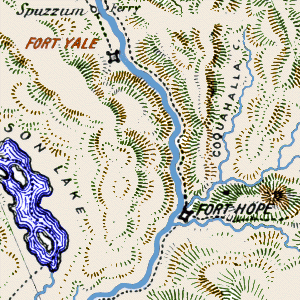
Town Tour
Architectural
Drawings
![]() St. John the Divine
St. John the Divine
![]() On Lee House
On Lee House
![]() Shilson House
Shilson House
![]()

The need for a new Hudson's Bay Company fur brigade trail opened the Yale region to the British.

|
| From "Map of the Gold Regions of British Columbia", 1862. Fort Yale and Fort Hope lie on the banks of the Fraser River. |
The year was 1848, and disputes between the Americans and the British had escalated to a point that the Hudson's Bay Company (HBC) could no longer use an existing fur trade trail along the Columbia river. To continue the transfer and shipment of animal pelts, the HBC were forced to find a viable fur trade brigade trail between Fort Kamloops and the navigable end of the Fraser River at Fort Langley. A route suggested by Alexander Caulfield Anderson proved to be the best choice under those circumstances. To traverse the new trail, the brigades would have to ford the Fraser near Spuzzum, and cross the treacherous mountains on the east side of the River.
What later became the town of Yale began as a small Hudson's Bay Company outpost.
A small outpost, to be named Fort Yale, was constructed at a point along the trail to service the brigades. Nestled at the lower end of the Fraser river canyon, the river bar on which it was built had served as a village site for the First Nations People for many thousands of years. Ovid Allard supervised the construction of a single log building with no stockades. Acting as an HBC trading post, it could also supply the needs of the passing fur brigades. That first year of the brigades  travelling on the new trail proved to be a disaster, losing 70 of 400 horses, 25 loads, and one human life. Another trail following a more southern route was created, and Fort Hope was built. For the next decade Fort Yale fell into disuse.
travelling on the new trail proved to be a disaster, losing 70 of 400 horses, 25 loads, and one human life. Another trail following a more southern route was created, and Fort Hope was built. For the next decade Fort Yale fell into disuse.
The Fraser River gold rush sparked a building trend that caused Yale to grow into a boomtown. Continue your tour to the Fraser River Gold Rush page to learn how it happened.
Home | Contents | Tour | People | Collection | Transportation | Just For Kids! | Team
|
Last updated 20 September 2000. This digital collection was produced under contract to Canada's Digital Collections Program, Industry Canada. Produced by Canada's Digital Collections Team. |

|
